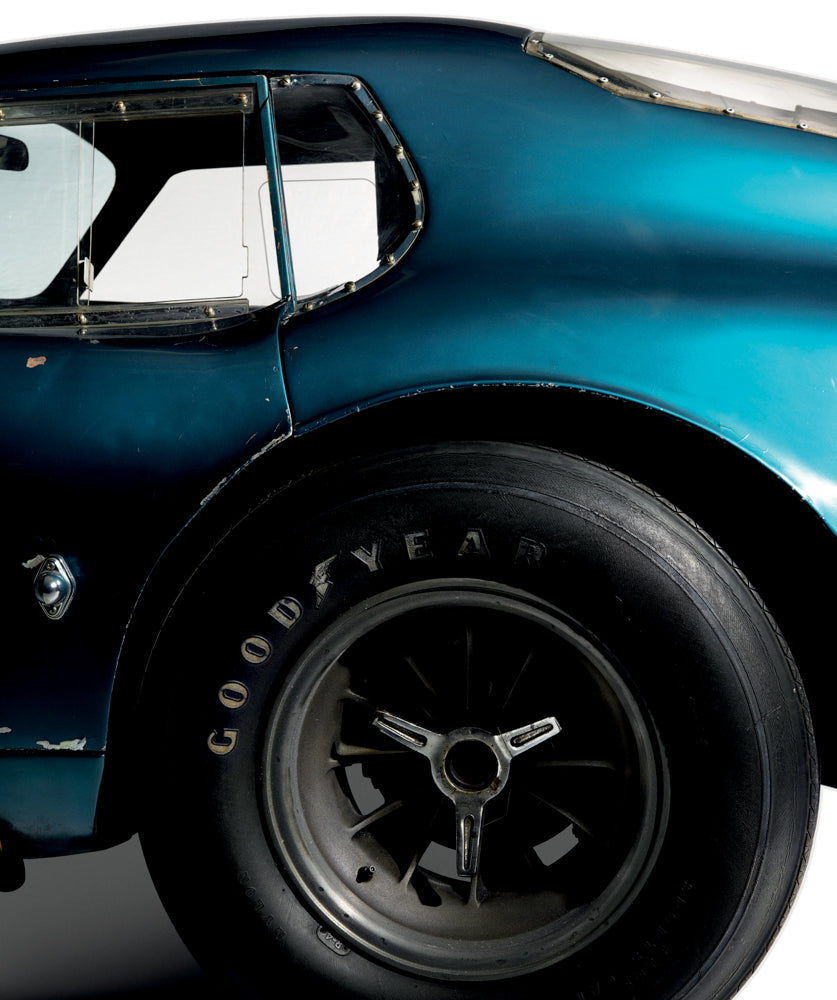
Lost & Found
LOST & FOUND

The peculiar case of the missing Shelby Cobra Daytona Coupe
For two seasons in the mid-1960s, the Shelby Cobra Daytona Coupe burned hot and bright on the international racing circuit. After bursting onto the scene, and into flames, at Daytona International Speedway in 1964, the car and its five duplicates proved the might of American muscle in 1965, bringing the FIA world manufacturer´s championship to the U.S. for the first time.
And then, as quickly as they made racing history, the Daytonas were put out to pasture. New rules for the 1966 season ended the careers of the six cars that had bested Ferrari the year before. The superstars became afterthoughts, left to collect dust in manufacturer Carroll Shelby's Venice, California, garage. For years, that's where five of them would remain. The original Shelby Daytona, often referred to by its serial number, CSX2287, was the exception. This Viking blue sensation would go on to set speed records at the Bonneville Salt Flats, careen through the Hollywood Hills with Phil Spector behind the wheel, and vanish for nearly three decades in a tale almost as startling as the Daytona's overnight success.


The story of CSX2287 begins in 1964 when Carroll Shelby, a former Le Mans winning driver who turned to manufacturing in the early sixties, set his sights on world domination. His first Cobra, built with the help of British auto company AC, carved up American raceways in 1962 and ™63, but Shelby knew that success on the much longer tracks of the old world required a Cobra that could strike faster.
Shelby put a young designer named Peter Brock on the case. An amateur in the field of aerodynamics, Brock’s plan was to rebuild the Cobra with a new roof and Kamm tail, among other alterations, while shifting around components under the hood. With no budget, the wrecked chassis of an AC Cobra roadster, and little encouragement from the rest of the Shelby team, Brock forged ahead. Initially known as “Brock’s folly,” among other, less-printable pejoratives, CSX2287 instantly became the most important project at Shelby American after it ran a test lap nearly four seconds faster than its predecessor.
This was only two weeks before its scheduled debut at Daytona, the track that would give the car its name. A rushed paint job followed and the newly dubbed Shelby Daytona was ready. It didn’t win — a freak fire in the pits prevented that — but the dominance CSX2287 showed that day foretold big things. Shelby promptly ordered up five copies of the car, and his six Daytona Coupes kept pace with Ferrari throughout the 1964 season, eventually finishing second in the GT class.
The following year, the Daytonas were unstoppable. Shelby’s fleet dominated the GT class and became the first American team driving American-made cars to win the FIA world manufacturer’s championship. But the celebration was short-lived. A new rule handed down by FIA, international racing’s governing body, required a production run of five hundred chassis in order for a car to qualify for the GT class.

“The answer was always the same. A hundred and fifty thousand? Nope. Half a million? Not interested. Two million? Get lost, pal.”
With its five duplicates in retirement, CSX2287 kept working, thanks to a call from Goodyear in November 1965. The tire company was sponsoring Craig Breedlove’s latest land-speed record attempt at the Bonneville Salt Flats. In order to keep its claim on the space while Breedlove’s Spirit of America was repaired, Goodyear needed to run another car. Shelby sent CSX2287 and Breedlove, along with Bobby Tatroe, went on to set twenty-three national and international speed records.
Once Shelby got the car back he sold it to Jim Russell, the founder of slot car company Russkit. Russell paid $4,500 for CSX2287 and sent it to Tijuana to have a proper interior installed. About a year later, Russell sold the car to crackpot record producer Phil Spector, then twentysix, who racked up so many moving violations in the car that he gave it or sold it — the history isn’t quite clear — to George Brand, a former cop who did work around Spector’s mansion. That’s when CSX2287 disappeared.
In the ensuing decades rumors about CSX2287’s whereabouts circulated, but those with a real interest in the car knew where to look. George Brand’s daughter, Donna O’Hara, had it in storage. She’d get an offer for it every so often but the answer was always the same. A hundred and fifty thousand? Nope. Half a million? Not interested. Two million? Get lost, pal. Even Carroll Shelby himself was rebuffed when he managed to track her down. She was “kooky,” he later told Car and Driver in its definitive account of the bizarre events that followed.

Early on a Sunday morning in late October 2000, O’Hara took her two rabbits and a jug of gasoline to an Orange County park. Huddled under a horse bridge, she doused herself in gasoline and struck a match. O’Hara’s rabbits died at the scene, but the fire didn’t kill her. She was found the next morning, begging to be left alone to die. She got her wish at a local hospital, and before long attention turned to the coveted piece of racing history she had kept hidden in an Anaheim storage locker.
Things would get uglier. A childhood friend of O’Hara’s said she had promised him CSX2287; her family claimed it was their inheritance. Then lawyer Robert Shapiro, of O.J.-Simpson-“Dream-Team” fame, showed up and announced that his client, Phil Spector, never actually sold the car to George Brand. The legal issues were eventually sorted out, and the car made its way to the garage of vintage racecar collector Dr. Frederick Simeone for a reported sum of just under $4 million. Today, were it ever to hit the auction block, it would sell for closer to $20 million. Entering its fifth decade, CSX2287, which became the first entry in the National Historic Vehicle Register last year, has traded its dusty storage locker for the Simeone Foundation Automotive Museum in Philadelphia, where it sits safely behind ropes, never to be forgotten again.




